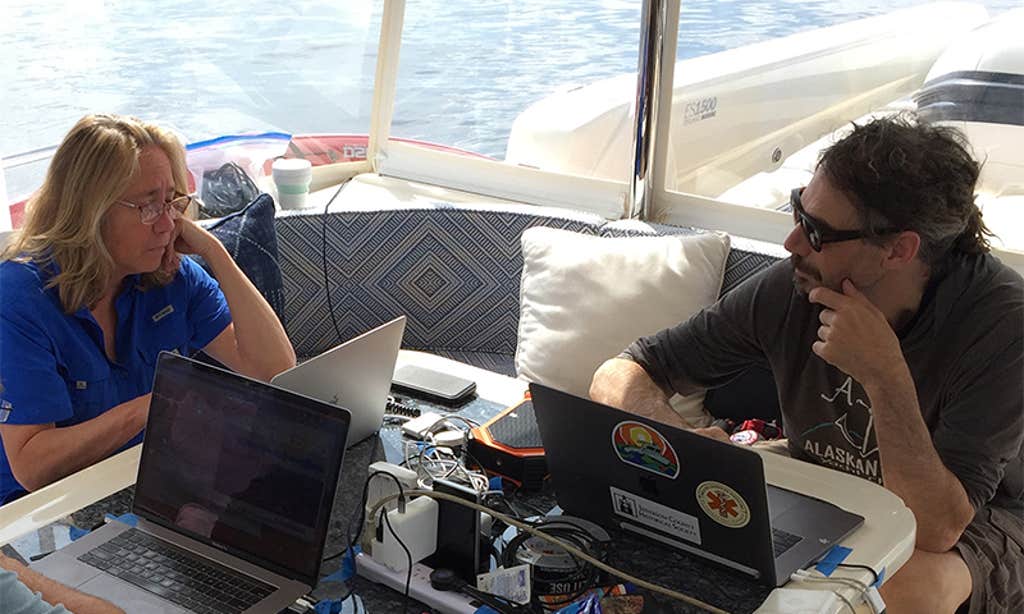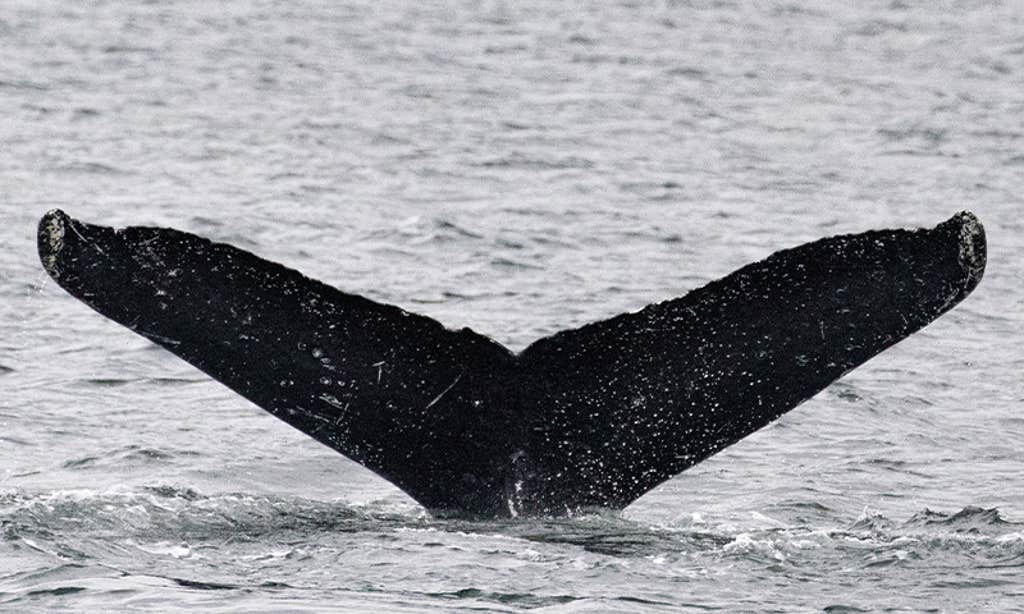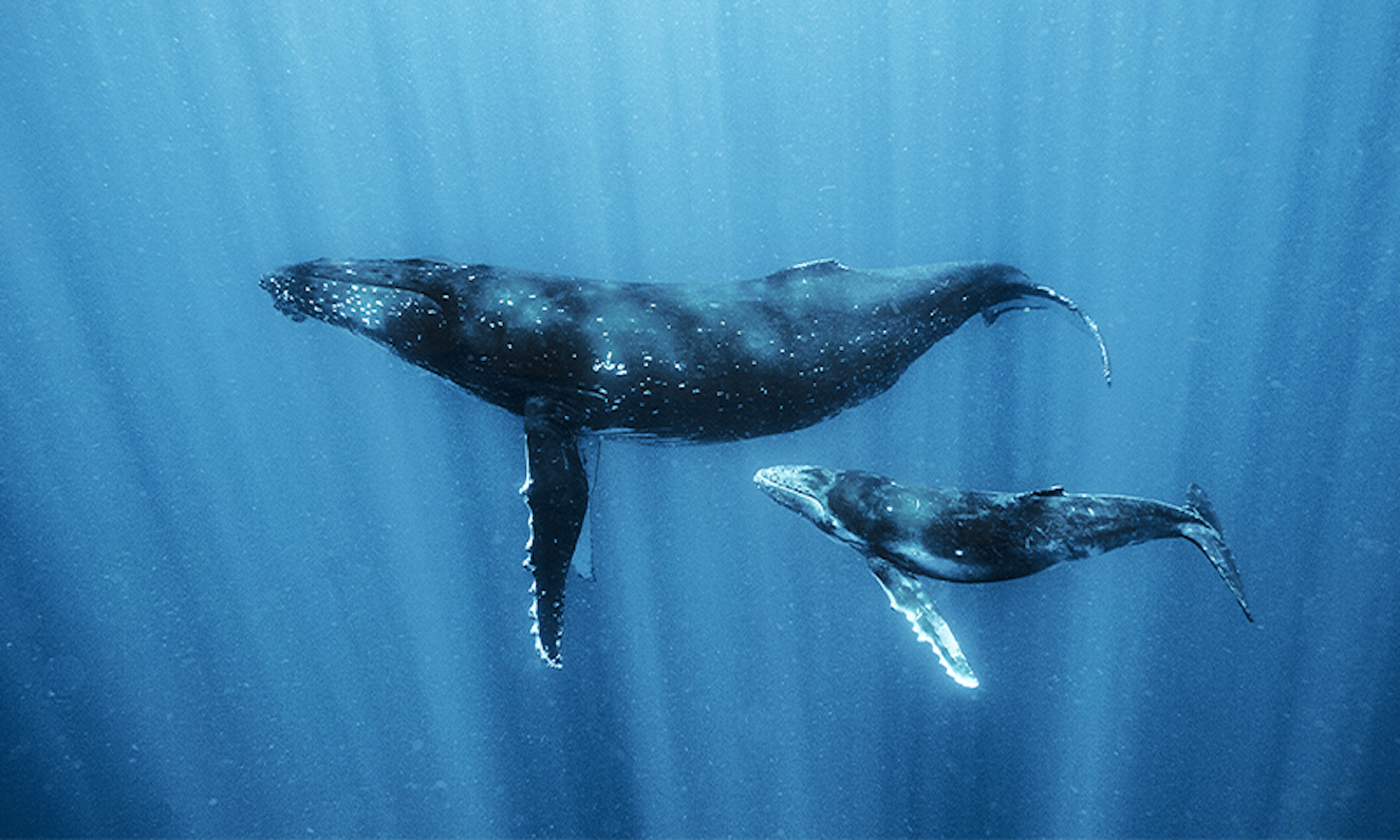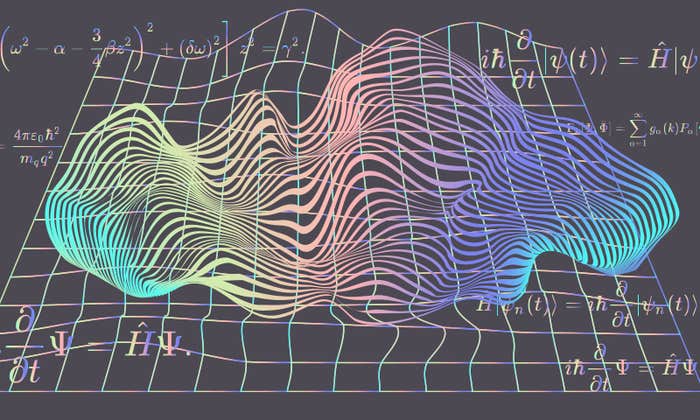On Aug. 19, 2021, a humpback whale named Twain whupped back. Specifically, Twain made a series of humpback whale calls known as “whups” in response to playback recordings of whups from a boat of researchers off the coast of Alaska. The whale and the playback exchanged calls 36 times.
On the boat was naturalist Fred Sharpe of the Alaska Whale Foundation, who has been studying humpbacks for over two decades, and animal behavior researcher Brenda McCowan, a professor at the University of California, Davis. The exchange was groundbreaking, Sharpe says, because it brought two linguistic beings—humans and humpback whales—together. “You start getting the sense that there’s this mutual sense of being heard.”
In their 2023 published results, McGowan, Sharpe, and their coauthors are careful not to characterize their exchange with Twain as a conversation. They write, “Twain was actively engaged in a type of vocal coordination” with the playback recordings. To the paper’s authors, the interspecies exchange could be a model for perhaps something even more remarkable: an exchange with an extraterrestrial intelligence.
Sharpe and McGowan are members of Whale SETI, a team of scientists at the SETI Institute, which has been scanning the skies for decades, listening for signals that may be indicative of extraterrestrial life. The Whale SETI team seeks to show that animal communication, and particularly, complex animal vocalizations like those of humpback whales, can provide scientists with a model to help detect and decipher a message from an extraterrestrial intelligence. And, while they’ve been trying to communicate with whales for years, this latest reported encounter was the first time the whales talked back.
It all might sound far-fetched. But then again, Laurance Doyle, an astrophysicist who founded the Whale SETI team and has been part of the SETI Institute since 1987, is accustomed to being doubted by the mainstream science community.
For years, Doyle sought out other worlds beyond our solar system. When he and others started looking for these worlds, they were rejected by the prevailing astronomy community. Now, we know there are thousands of exoplanets, some of which appear to be in the habitable zone around their stars—not too hot, not too cold, and a bit wet; they could harbor life, some perhaps even life complex enough to communicate across the cosmos.
Doyle and his peers use radio observatories to try to detect narrowband radio signals from outer space. SETI was founded on the idea that if extraterrestrial intelligences reached out to worlds beyond them, they would do so through radio signals, which travel at the speed of light and slice through space “noise” unimpeded. As SETI points out, the universe is full of “cosmic noisemakers,” including pulsars, quasars, and the interstellar gas of our own Milky Way. SETI focuses on narrowband radio signals because they can be distinguished from the cosmic noise, and, importantly, can only be produced by transmitters, meaning some intelligence must have designed them, and they must contain some form of information. Their nickname is “technosignatures.”
How much information does a humpback call carry at any one time?
Of course, after more than 50 years of radio astronomy, we haven’t detected a single technosignature. Even if we did, how might we interpret it? Are scientists even prepared for that question?
Doyle recounted a talk he gave to other SETI scientists. He had only five minutes and decided to spend one of them playing a humpback whale song. “I played a humpback whale song that lasted for maybe a minute. And then I said, ‘What if that had come from space? Is that intelligent?’ And everybody got it almost right away. They’re like, ‘Wow, we are not prepared, are we?’”
A big part of the problem is that scientists don’t have a way to tell whether an alien signal contains complex information or is even designed to be understood. They need to know both these things before they get anywhere near the hard work of assigning meaning to the information. The only way to start working on that problem, Doyle says, is to start practicing. And the only things to practice with are non-human species on Earth.

Doyle started this work back in 1999, when he proposed studying the clicks and whistles of bottlenose dolphins to try and find markers of complexity and intelligence in their linguistic repertoire. The idea, based on an earlier concept supported by Carl Sagan, was that studying—and ultimately, talking to—dolphins could help inform the search for signals coming from an extraterrestrial intelligence. In 2016, Nautilus spoke with Doyle about how dolphin communication revealed linguistic hallmarks that could, in turn, help separate a signal from the noise of the cosmos.
Since then, Doyle has turned his attention to humpback whales, which have even more complex communication. These creatures are the ideal practice partners, he says. They are highly intelligent, their calls are often extremely long, repetitive, and broadcast across vast swathes of ocean—and those calls contain complex information.
Like humans yelling at one another over a distance, some of what one whale is saying to another will be lost to the environment because of how far it must travel and the interference it meets along the way. Yet the whales still get the gist of what’s being said. That means some parts of the signal may carry more information than others, or perhaps some parts of the signal carry key pieces of information that let the whales fill in the blanks. The better scientists understand the nature of whale signals, the better they may be ready to understand the nature of alien ones.
Much of Doyle’s theories rest on information theory and, particularly, Zipf’s law, a principle in quantitative linguistics used to plot the frequency of a word or letter in a language against its frequency in any given text. For most human languages, word frequencies tend to follow a pattern of word distribution, where the most common word in the language is twice as frequent as the next most common. It’s not entirely clear why most languages appear to follow Zipf’s law.
One idea proposed by American linguist George Kingsley Zipf himself—and Doyle agrees—is that language is designed to be used and understood with minimal effort on both the speaker and listener’s part. For example, if a friend calls to you from far away and all you hear is “going … beach … Wednesday,” you can infer that someone is going to the beach on Wednesday. Zipf’s law is an expression of this.
Plotting linguistic data according to Zipf’s law can, in turn, reveal a language’s rules and syntax. If animal communication—or an extraterrestrial signal—follows Zipf’s law, scientists can assume it is a language, and then make inferences about the information carried within the signal. “We discovered syntax in humpback whales, so they have structure in their communication system,” Doyle says.

“Looking at the way other organisms communicate is a useful way of saying, ‘OK, is there a language fingerprint? Is there not a language fingerprint?’” says Arik Kershenbaum, a zoologist at Cambridge University, who studies animal communication and is a board member of the thinktank Messaging Extraterrestrial Intelligence, focused in part on designing messages to be received by an extraterrestrial intelligence. Kershenbaum is not part of the Whale SETI team.
“Do whales have a language? My guess is no,” Kershenbaum says. “I think they probably don’t. But I think the communication is complex enough that we can use it to build physical models of what complex communication is.” In turn, Kershenbaum says, that could help SETI scientists tell how much information is in a signal from outer space.
“That’s where the real advantage of this approach is: Can we quantify the amount of information in a signal?” Kershenbaum says. “Whereas it’s not very helpful when you start thinking about translating.”
Kershebaum hits on the fact that once scientists have a snippet of complex communication, whether from a humpback whale or an alien intelligence, they are still largely unable to assign meaning beyond making broad assumptions based on the context of the communication.
“We can use things like AI and other machine learning-type systems to find patterns in the data,” animal behavior expert McCowan explains. “But the patterns alone are not going to be enough. We’re going to need to understand what those patterns mean. And that’s the hard work animal behaviorists and animal communication researchers focus on.”
What if that had come from space? Is that intelligent?
Doyle describes this as a search for carrying capacity—in other words, how much information does a humpback call carry at any one time? And, in turn, how much uncertainty is there in their calls? Humans, for example, can still get the gist of a message even if chunks of it are missing, and it’s possible the whales do something similar.
The next step for Whale SETI is to use AI to refine the whale playback calls in the hope that a future encounter might lead to a more dynamic “conversation,” whereby the whale and the researchers could exchange vocalizations in a more natural way. Ultimately, they want to better understand how much information is carried in the whales’ different calls and, perhaps, get a sense of what they mean.
Kershebaum makes the analogy of the 2016 sci-fi movie Arrival, when linguist Louise Banks (played by Amy Adams) manages to translate a complex alien language she has never come across fast enough to save the world.
“It’s not going to be like that because we haven’t started” decoding non-human communication on Earth, Kershebaum said. “And the place to start is with that complex animal communication. It is the only thing we’ve got.”
One particular aspect of humpback communication, over most other animal communication, that could help SETI, Doyle says, is their ability to transmit messages across vast distances and have them be understood. If SETI scientists can work out what pieces of information are crucial to humpback understanding, it could in turn help them pinpoint where relevant information might lie in a technosignature that has been broadcast over a vast distance in space and time.
In fact, Doyle says, the whales have already answered at least one big question for SETI scientists.
“A big assumption of SETI right now,” Doyle says, “is that ET will be curious and will want to be contacting us. And that’s something we can investigate like the encounter with Twain. Twain heard ‘hello’ in humpback and came over!” ![]()
Lead photo by Jodi Frediani; NOAA Permit 19703

























